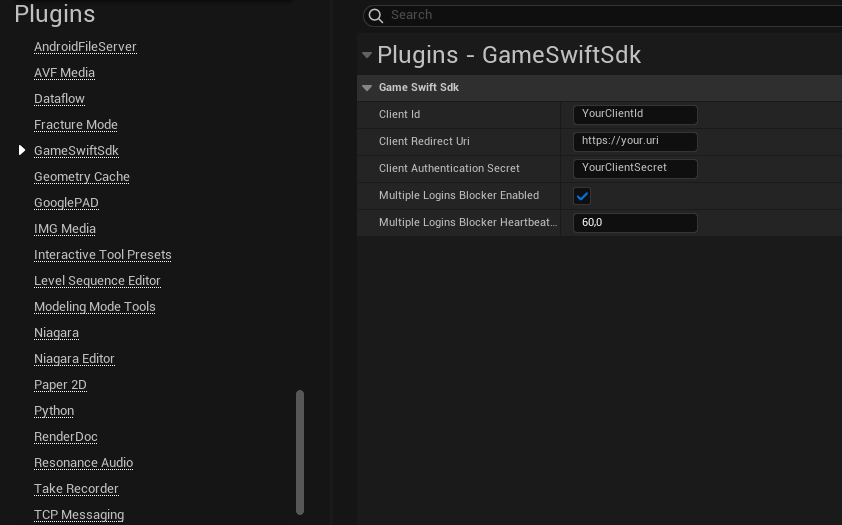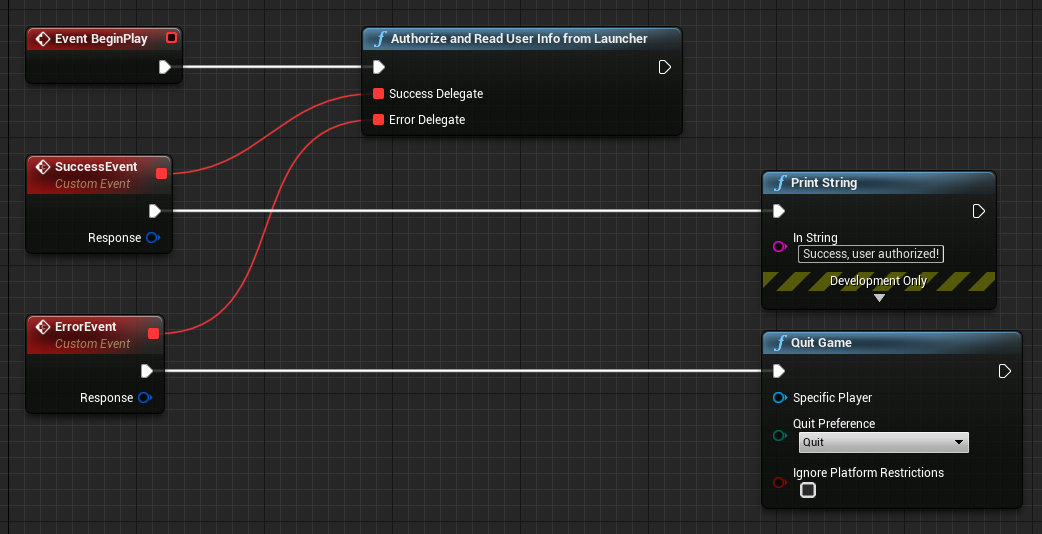GameSwift Unreal SDK is a toolset created to to help you seamlessly integrate GameSwift ecosystem into your Unreal Engine projects. Key features of GameSwift Unreal SDK are:
-
Rapid integration
Installation and integration process is streamlined and can be completed in under 30 minutes. This means you can focus more on building your game and less on complex API integration.
-
Safety
Firstly, GameSwift Launcher is equipped with a robust DRM system that guarantees players launch your game without altering any game files. Secondly, Multiple Logins Blocker ensures that a user account is logged in from exactly one device at a time. Both of these features prevent various types of abuses and help you maintain a secure and fair gaming environment.
-
Blueprint support
All SDK features can be accessed both in C++ code and in the Unreal Engine Blueprint system. This versatility ensures that not only programmers but also non-coding individuals can work on GameSwift ecosystem integration.
-
Multiplatform support
The wrapper is designed to work seamlessly on multiple platforms, making it adaptable for a variety of game development projects. You can bring the best gaming experiences with GameSwift Unreal SDK for Windows, MacOS and mobile.
GameSwift Unreal SDK is compatible with Unreal Engine versions 4.24 and beyond. We are committed to keeping it up-to-date with newer Unreal Engine releases, including Unreal Engine 5 and upcoming versions.
-
Add SDK to you project. This can be done in two ways:
- Add SDK as git submodule to your repository by invoking the
following command:
git submodule add https://github.com/GameSwift/gameswift-unreal-sdk YourMainProjectDir/Plugins/GameSwiftUnrealSdk
- Download this repository contents
from newest release and unpack the plugin to
the
Plugins/GameSwiftUnrealSdkfolder. If you don't have aPluginsfolder in your main project directory yet, create it.
- Add SDK as git submodule to your repository by invoking the
following command:
-
Open Project Settings in the editor and navigate to
Plugins > GameSwiftSdk. Fill in following fields:ClientId,ClientRedirectUri,ClientAuthenticationSecret. These secrets are distributed by GameSwift. -
Add
GameSwiftSdktoPublicDependencyModuleNamesin your main*.Build.csfile.
You can handle GameSwift login in 2 ways: with launcher or without launcher. You can download GameSwift launcher here. As long as your game targets Windows or MacOS, we strongly recommend to use data passed from our launcher. By doing so, you won't need to implement any login screen for your game as launcher already handles user credentials ina secure way.If you are building for mobile, you will need to create a login screen and implement connection with GameSwift backend the other way.
No matter which approach you choose (C++ or Blueprints), be sure that AuthorizeAndReadUserInfoFromLauncher
or LoginAndAuthorize is called at the application startup.This method wil succeed provided that:
- User has internet connection.
- User did not attempt to login simultaneously from multiple devices (applicable only for applications with Multiple Logins Blocker enabled).
- User launched the game via launcher instead of your game executable file (provided that you used with launcher flow).
Otherwise, you should retry calling this method or close the application as it may not be launched the intended way.
Authorizing the user and getting his info can be done by
calling UGameSwiftAuthenticationManager::AuthorizeAndReadUserInfoFromLauncher.
void ASampleCharacter::ReadUserInfoFromLauncher()
{
FGetUserInfoDelegate SuccessDelegate;
SuccessDelegate.BindUFunction(this, "OnSuccess");
FBaseSdkFailDelegate FailDelegate;
FailDelegate.BindUFunction(this, "OnError");
UGameSwiftAuthenticationManager::AuthorizeAndReadUserInfoFromLauncher(SuccessDelegate, FailDelegate);
}
void ASampleCharacter::OnSuccess(const FOAuthUserInfoResponse& Response)
{
// success - you can read user nickname and other data from Response
}
void ASampleCharacter::OnError(const FBaseSdkFailResponse& Response)
{
// fail - close the application or retry authorization
}AuthorizeAndReadUserInfoFromLauncher node is responsible for authorizing the user, who accessed the game through
GameSwift Launcher.
With this approach you need to create a custom login widget, which will enable user to input the login data and authorize.
Authorizing the user and getting his info can be done by calling UGameSwiftAuthenticationManager::LoginAndAuthorize.
void ASampleCharacter::LoginAndAuthorize()
{
Fstring EmailOrNickname = "[email protected]";
Fstring Password = "Password123";
FGetUserInfoDelegate SuccessDelegate;
SuccessDelegate.BindUFunction(this, "OnSuccess");
FBaseSdkFailDelegate FailDelegate;
FailDelegate.BindUFunction(this, "OnError");
UGameSwiftAuthenticationManager::LoginAndAuthorize(EmailOrNickname, Password,
SuccessDelegate, FailDelegate);
}
void ASampleCharacter::OnSuccess(const FOAuthUserInfoResponse& Response)
{
// success - you can read user nickname and other data from Response
}
void ASampleCharacter::OnError(const FBaseSdkFailResponse& Response)
{
// fail - close the application or retry authorization
}GetUserCredentials node in the sample below is your implementation of retrieving login data from your custom login
widget. Then, you can pass retrieved data to LoginAndAuthorize node.
Multiple Logins Blocker is an optional, powerful feature of GameSwift Unreal SDK that ensures a user's account can
only be logged in on one device at a time. This component's setup is done in Project Settings
under Plugins > GameSwiftSdk.
If enabled, this component works in background of your game, sending periodic heartbeats to GameSwift server at time intervals specified by you. When server receives these heartbeats, it recognizes that the user is already logged in and will block any additional login attempts from this user for a configurable duration. If you want to configure the lock duration, feel free to contact us.
If you have any questions, concerns, or feedback, please don't hesitate to reach out to GameSwift team. We're here to assist you and can be contacted via email at [email protected].


